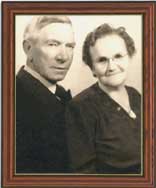|
THE BEAVER PRESS Thursday, February 22, 1979
Around Town
with Marge
TRUE PIONEER STORIES
THE NIELS JENSEN STORY
November was the month of his birth. The topaz
his birthstone, the chrysanthemum his flower. Niels Jensen,
a long time citizen of Beaver, was born in Parowan in 1873,
a son of Peter and Boudild Marie Jensen. His life began when much
of the old west was still with us, when men and horses were
the motive power. Boys of twelve years of age were already
good teamsters and helped much to provide for the family
needs. In those days, making a living was a difficult and
full time job. Mr. Jensen was the same type of man as those
who helped to bring the wagon trains across the prairies,
who blazed the trails and felled the tall timbers, who cut
the great slabs of granite, who made and laid the brick for
homes, schools, and churches, who turned the soil and planted
grain, who kept silent vigil over the herds at night while
watching with sharp eyes and listening with keen ears for
the tricky Indian
When about 12 years old, Niels lost his mother. To him this
was one of the saddest moments of his life. He had turned to
her with all of his youthful problems and shortcomings. He
had sought her wisdom, council and helpful decisions at all
times. She had been his guiding star. At her death, he was
like a little boy lost. The earth had suddenly been pulled
from under his feet. The sorrowing family had been drawn
closer together. The father kept him close, taking him along
on many freighting trips. His two older sisters tried to keep
him in school, but there were interruptions when there were
jobs to do. He soon learned the ways, means and responsibilities
of caring for a team and wagon loaded with freight.
Soon after his mother died, the family moved to Richfield. They
went by way of Little Creek Canyon. The weather was bad, but it
took a turn for the worse with sleet, snow and a north wind.
While going over a dugway, the wheels of the wagon bogged down
in the deep mud. For a while they were stranded, wet, hungry and
tired. Wood was water soaked. The father went back to the wagon,
pulled out the old wooden bed and chopped it up for firewood.
After a good warm meal their strength and courage were somewhat
restored. After working furiously to get the wagon out of the
mire, they resumed their journey and camped for the night in
Bear Valley.
After reaching Richfield, Niels soon found a job herding cows for
five cents each, per day. He managed to get five cows and felt very
fortunate to be making 25 cents a day. It wasn't long, however,
before he was driving his father's freight wagon from Richfield to
such points as Pioche and Ely, Nevada, Milford and De Lamor, Utah
and other places where their produce could be sold.
From Richfield, Utah to Pioche, Nevada and back was about a 300 mile trip;
a big undertaking for a boy of 14. When he was about 15 years old,
he accepted a contract to haul mail from Taylor, Utah, a mining
town, to Ely, Nevada. He worked steadily at this job for four years.
Later in years, he received a contract to drive the mail from Milford
to St. George. On one of these trips, he was caught in a heavy snowstorm.
While trying to make it to the Buckhorn flat, he was almost lost in the
blinding snow, and so he decided to return as far as the Beaver
Ridge and wait. He cleared away the snow from around the white topped
buggy, tied up the team, made a fire and waited for daylight. He moved
on about 7 a. m. and reached Parowan, cold, tired and hungry. His
young days were filled with experiences of this kind. He never turned
down work if he could make an honest dollar.
While still living in Richfield, his sisters heard that Beaver was paying
good wages for good cooks, so they decided to move to Beaver. They brought
with them the family organ which the girls loved. They were fine
singers and many was the evening they gathered around the organ with
neighbors and friends to sing and play. Niels was their driver and all
went well until they reached Pine Creek Hill. Here the horses
balked and refused to move. Niels tried every known method to start
them, but to no avail; so the three sat down by the roadside
to wait. Someone may come along who could help them. They waited a long
time, told stories and sang songs, but no sound came from the road. No one
was coming their way on that day. Soon there was complete silence. Suddenly,
like a flash from the blue, the horses bolted up the hill as fast as they
could go with such a load. Neils leaped to his feet and ran after them. The
girls screamed out, "Oh, our organ, our lovely organ. It will be
smashed to pieces!" Niels shouted back, "The devil take the old organ, run!
Let's get in the wagon. If the horses have decided to go on, we may make Beaver
by night fall." At the top of the hill, the team had come to a stop and was
all out of wind. The travelers took advantage of this opportunity to climb into
the wagon. They reached town in safety, organ and all. Thus began their life
in Beaver.
Niels Jensen has always been a hard worker. He was never without a good team
of horses and a good wagon. He treated them with kindness and a steady hand.
Many men still remember one of his favorites, a span of big and powerful
buckskins, pulling huge loads of the best wood obtainable. When Niels brought
in wood from the hills, you got your money's worth. For years, he was the champion
of all haulers. He was a man of great strength, stability, courage and with a big
understanding heart. His parents, being Pioneers, he was called upon, even
as a boy, to endure many hardships and make many sacrifices which in turn
prepared him for the years ahead.
In the early days of the west, God needed leaders of every profession. He called
them all. He also needed, and in great numbers, the brave rugged men of the
out-of-doors. Side by side they struggled, conquering and subduing
this wild and
uncharted land. In his day, Niels Jensen did his share.
In 1928, Niels Jensen was elected Sheriff of Beaver County. He served in this
capacity for many years, receiving as his monthly salary $114, which, he said,
"is somewhat different than they pay today, and we had a heck of a lot more to do."
It was back in the year 1898 that he married one of Beaver's fine young women, Kate
Bell Levi. To this union were born four lovely daughters, Clerynth, Norma, Letty,
and Faye. Mr. and Mrs. Jensen loved their home in Beaver and had many friends
throughout the entire County.
From D.U.P.(Daughters of Utah Pioneers) files. NOTE: It seems a long time
since I called at the home of Niels Jensen, retired. I was writing his history
for the records of the D.U.P. Organization. It was a lovely afternoon and we
sat out on the front porch. He was very kind and cooperative and seemed
to enjoy telling of his past. We laughed together at the weird and comic
versions that came unexpectedly into some of the dull and heartless days. When
he spoke of his mother and his boyhood days of long ago, his eyes filled with tears. Such
moments are not uncommon even to the strong and rugged men of the great open spaces.
My thoughts flashed to the words of the poet Dryden, "I have not wept these 40 years,
but now my mother comes afresh into my eyes."
This story of Katie Bell (Levi) Jensen is taken from notes written by her daughter
Norma about 1960.
Sister Kate Jensen was born in Beaver, Utah on September 12, 1878. She was one of six
children born to David and Ann (Gillispie) Levi, pioneers and early settlers of Utah.
Her brothers and sisters consisted of two girls who died young, a sister Julia Ann Howd,
a sister Nettie Yardley, and a brother William D.
Her father David had two wives, his second wife was Christine (Gillies) Levi. This second family
consisted of six boys, Robert, James, Fred, Karl, Marshall and Orson. Their home was right
across the street.
David Levi, being a cattle man and farmer, owned the home and pasture land which is now
the Jensen home. He also owned the pasture land surrounding the Taylor Farnsworth milk
barn.
Loving out door life, Sister Kate spent a happy childhood riding horses, skating, dancing
and picnicking with her brothers and many friends. She remembers her first teacher, Lucinda
Dalton, whom they all called Auntie Low. She went to school at the old Central School House
and in order to enter school, she and her mother stopped in at the court house to buy
a permit that cost $2.00 for one term. Sister Kate was a faithful attendant
of Primary,
Sunday School and Mutual. At the age of eight, she was taken by her sister Nettie down to
the Beaver River to be baptized.
Brother J. F. Tolton taught Sister Jensen in the grade schools and she
received several awards of merit for her outstanding work.
She graduated from high school at the age of sixteen and her school days ended. College
was for boys - house making for girls was her fathers belief. Therefore, she continued
her work in the Mutual and Sunday School. Many of her school friends, Hilda Lessing, Nell
Wilden and Dr. Warren Sheppard grew to be life long friends.
At the age of 20, Sister Kate married Niels Jensen, born in Parowan. They were married, in
the home that they are now living in, by Brother J. F. Tolton on the 26th of October, 1898.
They were later sealed in the St. George temple. On October 26, 1958, they celebrated their
60th wedding anniversary.
Their early married life was spent in Richfield, Utah. Three children, Clerynth,
Norma and Letty were born to them. Many friends were made but there are no friends like old
friends, so that in 1909 they moved back to Beaver. They settled in the old Levi home, her
parents having passed away.
Home again, she began by working in the Primary, which was held in the old Park Hall.
Sister's Mary Goodwin, Grace Jones, Kathy Muir, Nora While and Nell Morgan were some of the
sisters she worked with. Each Saturday, Sister Nora White, driving her buggy,
would stop for the Jensen's and regardless of the weather, Ellen, Erma, Norma and Letty were
taken to Primary. In 1919, another daughter, Julia Faye, was born. In 1921,
Sister Kate was called as secretary in the West Ward Relief Society, by Bishop
George Paice. for four years she worked with Sister Hattie Bohn as President, in
a labor of love, caring for the sick and preparing the dead for burial. Many
homes knew the touch of their loving hands in sickness or food and clothes, if
there was need.
In 1927, she was chosen by Bishop Wesly Farrer, as President of the
West Ward Relief Society. Working with her
counselors, she walked many a mile from
her home to the Relief Society Building, located by the Belknap School, to attend
her meetings and fulfill many errands of mercy. Not being a trained nurse,
she voluntarily assisted Dr. Fairbanks and Dr. Hopkins in many cases
when help was unavailable.
In 1931, under the leadership of President Thomas W. Gunn, sister Kate was made
Stake Relief Society President. This office she filled for nine years. Her
trips to the General Conference and her Temple Excursions were numerous.
In 1940, she was chosen as the Stake Relief Society Welfare Leader and served for five
years. Sister Jensen still serves her church as a Relief Society Teacher and each
month goes with Sister Lottie Farrer on her district visits. On September 12, 1958,
she celebrated her 80th birthday. She is a cherished friend of many in the community,
the mother of four daughters, grandmother of 12,
and great grandmother of many.
|

|
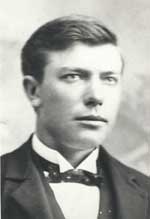
|
Grandpa Niels at the time of his marriage
photolink
|
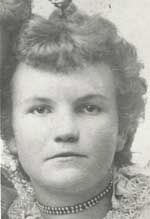
|
Grandma Katie Bell Levi at the time of her marriage.
photolink
|
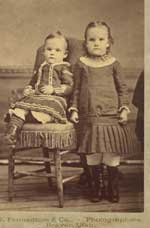
|
Katie Bell and her brother William David Levi
photolink
|
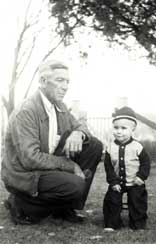
|
Grandpa Niels and Richard on the Jensen front lawn.
photolink
|
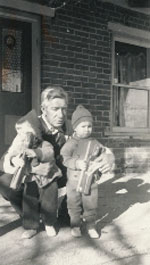
|
Robert, Grandpa Niels, and Richard
Photolink
|

|
Grandma Katie Bell (Levi) Jensen
Photolink
|
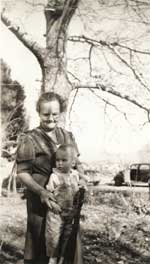
|
|
Grandma Kate and Richard Easton
on her front lawn.
Photolink
|
|








